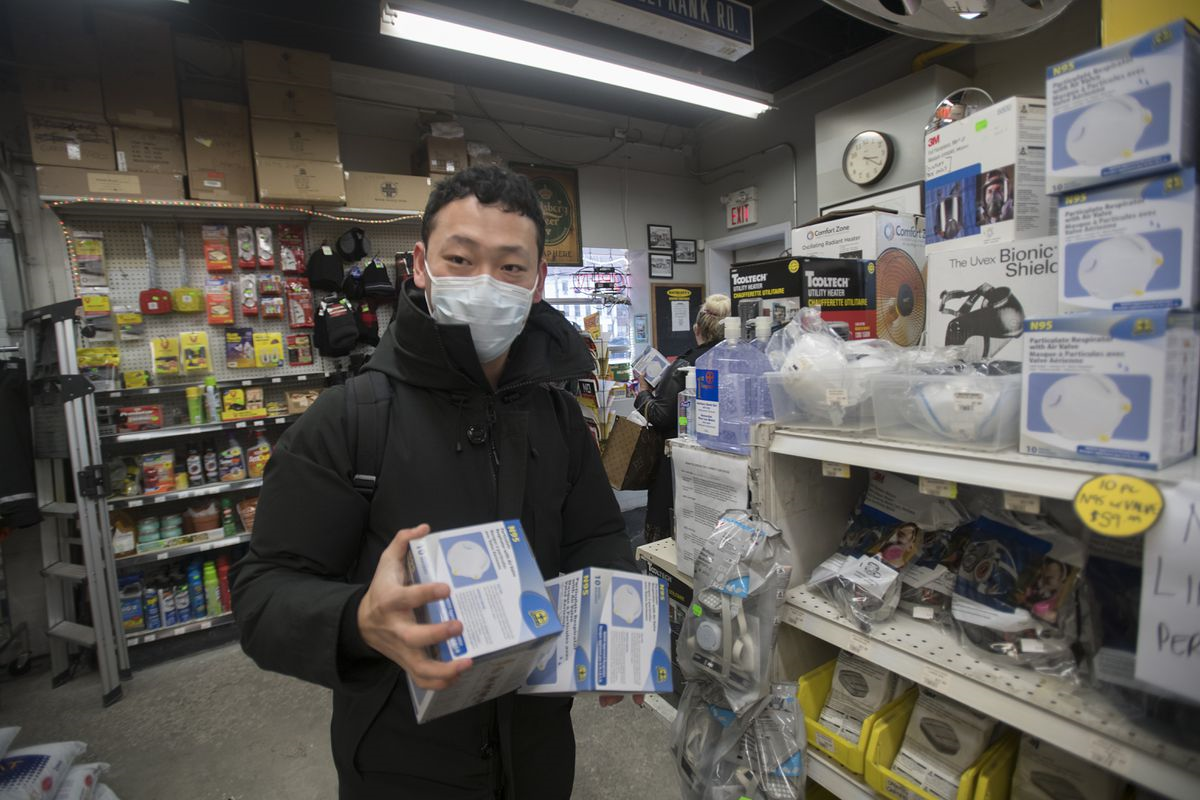
Rotblott’s, a discount warehouse has sold 3,900 N95 masks in the last week – one such customer, Tony Lyu, seen here on Jan. 27, 2020, bought two boxes of N95 masks. FRED LUM
Rotblott’s, a discount warehouse has sold 3,900 N95 masks in the last week – one such customer, Tony Lyu, seen here on Jan. 27, 2020, bought two boxes of N95 masks. FRED LUM[/caption]
Rotblott’s, a discount warehouse has sold 3,900 N95 masks in the last week – one such customer, Tony Lyu, seen here on Jan. 27, 2020, bought two boxes of N95 masks. FRED LUMRotblott’s, a discount warehouse has sold 3,900 N95 masks in the last week – one such customer, Tony Lyu, seen here on Jan. 27, 2020, bought two boxes of N95 masks. FRED LUM
By the time Henry Xu got his hands on a few boxes of N95 respirator masks at a Toronto hardware warehouse on Monday, he had already struck out at all the major online retailers and a local drugstore.
“Originally, we were planning on buying those surgical masks,” the 27-year-old University of Toronto graduate student said, “but those are pretty much sold out everywhere.”
Mr. Xu managed to find the N95 masks – so named because, when fitted properly, they block 95 per cent of fine particles – at Rotblott’s, a discount warehouse that has sold 3,900 N95 masks in the last week, according to owner Andrew Rothblott.
Surgical and N95 masks are in high demand in Canada, despite public-health officials saying there is scant risk the country will experience an outbreak of the novel coronavirus that has spread rapidly across China.
A spokeswoman for 3M Canada, which makes N95 respirators, confirmed the company has seen an increased demand for the tight-fitting masks. Drug stores, meanwhile, are struggling to keep paper surgical masks in stock.
“We’ve checked with pharmacists in four provinces, including Ontario, and they’re all reporting either brisk sales of masks or they’re out and having difficulty getting resupplied,” said Barry Power, an Ottawa pharmacist and spokesman for the Canadian Pharmacists Association.
Even if Canada were to see a rash of cases of the new SARS-like virus, public-health leaders say masks wouldn’t necessarily stop the spread of the virus.
Masks could, in fact, spread something else: panic.
“We never recommend wearing a mask in public,” David Williams, Ontario’s chief medical officer of health said Monday after he announced that a second “presumptive” case of the SARS-like coronavirus had been identified in Canada.
The trouble with masks, according to Dr. Williams and other public-health leaders, is that the general public doesn’t always use them properly or consistently. People often reach under the masks to touch their nose or mouth, which spreads germs, Dr. Williams said.
Susy Hota, the medical director of infection prevention and control at the University Health Network in Toronto said she has seen people wear surgical masks upside down, inside out and with their noses exposed.
Research on the effectiveness of masks in the general public is mixed. One Australian study published in 2009 found that wearing a surgical mask in daily life significantly reduced the risk of catching influenza, but fewer than half of the study participants wore masks most of the time.
It’s a different story in health-care settings such as hospitals, where nurses and doctors are trained to don and doff personal protective equipment properly, Dr. Hota said. For front-line health-care workers caring for patients suspected of carrying the new virus, masks are indispensable, she added.
Dr. Hota said the sight of masked people in public places could make the public start to wonder: “Am I missing something? Should I be doing the same? That’s the kind of reaction that I would anticipate you get when you start to see lots of people walking around with masks.”
Children could find the sight of masks unsettling. One school board, in Peel Region, west of Toronto, sent an e-mail to parents Monday asking them not to send their children to school in masks, because they are, “often used incorrectly, spread unnecessary panic in communities, and may cause increased risk of infection to the user.”
KELLY GRANT, HEALTH REPORTER
The Globe and Mail, January 27, 2020
